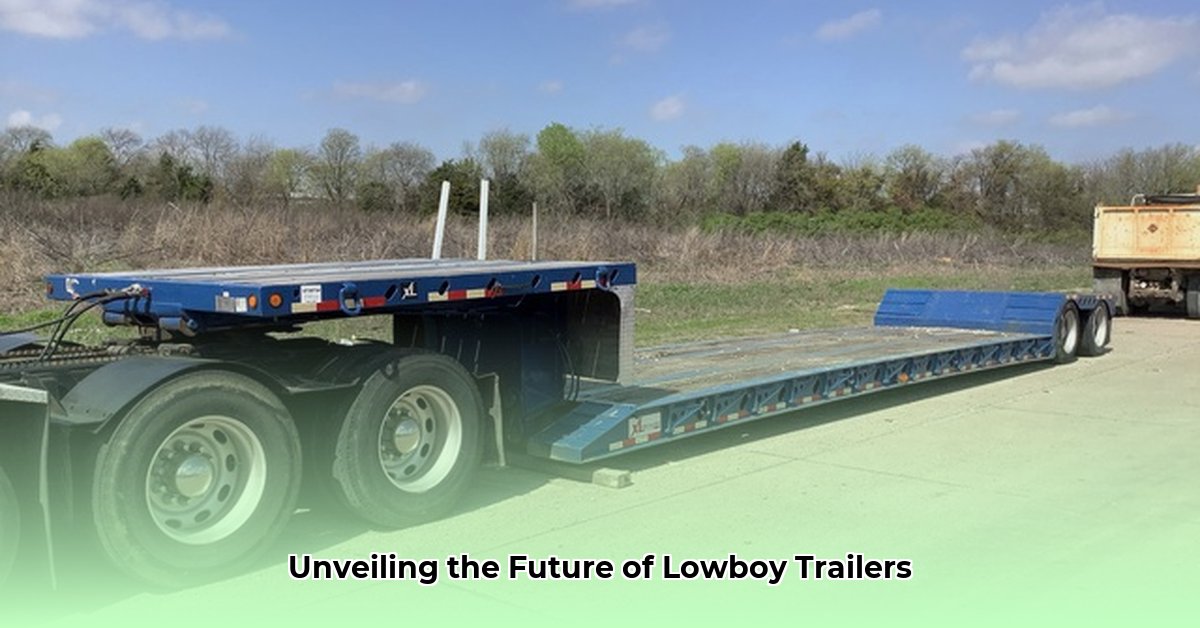
The lowboy trailer market, a crucial segment of the heavy-haul transportation industry, is experiencing significant transformation driven by technological advancements, evolving safety regulations, and fluctuating market demands. For more specifics on trailer dimensions, see tractor trailer dimensions. This article analyzes current market trends, identifies key challenges and opportunities, and offers actionable strategies for stakeholders to navigate this dynamic landscape.
Understanding the Lowboy Market Segmentation
The lowboy trailer market is not monolithic. It's segmented based on the type of cargo hauled, including:
- Wind Turbine Components: Specialized trailers are required to transport oversized wind turbine blades and nacelles.
- Construction Equipment: Heavy machinery like excavators, bulldozers, and cranes demand robust and adaptable lowboy solutions.
- Industrial Machinery: Large industrial components and manufacturing equipment necessitate specialized transport solutions.
Regional variations also affect market dynamics, with differing infrastructure, regulatory environments, and transportation demands impacting operational strategies.
Key Trends Reshaping the Lowboy Hauling Landscape
Several pivotal trends are reshaping the lowboy transport industry:
Lightweight Materials Adoption: The increasing use of advanced materials like aluminum alloys and high-strength steels aims to reduce fuel consumption and increase payload capacity. However, higher initial costs and potential maintenance complexities need careful consideration. Will the cost savings from increased fuel efficiency outweigh the higher initial investment in lightweight materials? A recent study suggests a potential 15% reduction in fuel consumption with aluminum lowboys, but further research into long-term maintenance costs is needed.
Enhanced Safety Regulations: Stricter regulations are driving improvements in braking systems, load-securing technologies, and driver training programs. While enhancing road safety, these improvements increase operational costs. How can transportation companies balance the need for enhanced safety with the increased financial burden of upgraded equipment and training? The implementation of electronic braking systems (EBS) and advanced driver-assistance systems (ADAS) is expected to significantly improve safety, but their high initial costs and potential maintenance requirements must be addressed.
Technological Integration: Telematics systems are becoming ubiquitous, providing real-time data on location, trailer status, and cargo monitoring. Furthermore, the exploration of autonomous driving technologies offers the potential for significant improvements in efficiency and safety. What are the practical challenges and regulatory hurdles to overcome before widespread adoption of autonomous lowboy systems? Early pilot programs indicate a potential 10% increase in operational efficiency through optimized routing and reduced idle time with telematics. However, the transition to fully autonomous systems faces significant technological and regulatory hurdles.
Strategies for Success: A Stakeholder Perspective
Successful navigation of the evolving lowboy market requires tailored strategic approaches for different stakeholders:
| Stakeholder | Short-Term Strategies | Long-Term Strategies |
|---|---|---|
| Trailer Manufacturers | Focus on enhanced safety features; explore lighter, stronger materials; optimize manufacturing processes. | Invest in R&D to develop innovative materials and autonomous system integration; expand product lines to diverse market segments. |
| Transportation Companies | Optimize routes; negotiate favorable lease agreements; leverage telematics for operational efficiency. | Invest in driver training on advanced technologies; adopt fuel-efficient practices; explore strategic partnerships. |
| Regulatory Bodies | Enforce existing safety regulations diligently; promote industry best practices. | Develop regulations for autonomous lowboy operation; encourage the adoption of sustainable transportation solutions. |
| Infrastructure Developers | Collaborate with haulers to anticipate future infrastructure needs; invest in road upgrades. | Design infrastructure capable of accommodating heavier and larger loads; improve roadside safety and emergency response capabilities. |
Risk Mitigation: Proactive Strategies for Success
Several potential risks require proactive mitigation strategies:
| Risk Factor | Risk Level | Mitigation Strategy |
|---|---|---|
| High initial costs of lightweight materials | Medium | Conduct thorough cost-benefit analyses; explore financing options; prioritize gradual adoption. |
| Integration challenges of autonomous systems | High | Phased implementation; robust testing and validation; secure regulatory approvals; address cybersecurity concerns. |
| Supply chain disruptions | Medium | Diversify suppliers; establish strong contract terms with reliable partners; maintain adequate inventory levels. |
| Lack of skilled drivers for advanced technologies | High | Invest significantly in driver training programs; offer competitive compensation and benefits packages. |
The Future of Lowboy Hauling: A Path Forward
The lowboy trailer market presents opportunities for those who adapt and innovate. Companies that proactively address emerging trends, develop data-driven strategies, and effectively manage associated risks are poised for success. The future entails not only moving heavy loads efficiently, but also achieving optimal safety and sustainability. Collaboration among stakeholders, continuous technological advancements, and a commitment to addressing present challenges will pave the path toward a flourishing future for the lowboy transportation industry. Dr. Emily Carter, Professor of Chemical and Biological Engineering at Princeton University, notes: "The transportation sector remains a significant contributor to global greenhouse gas emissions. The adoption of lightweight materials and autonomous systems in the lowboy industry offers immense potential to reduce the environmental impact of heavy-haul transportation." This underscores the importance of continued research and development in sustainable lowboy solutions.